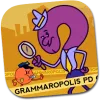Take a look inside 6 images
Punctuation - End Marks
Pros: Great story, detailed lessons, and tough quizzes make for a great cross-training in grammar.
Cons: Lessons on abbreviations and capitalization are equally important but less clearly integrated into the app's central story.
Bottom Line: A thoughtfully designed, consistently engrossing tool for learning key grammar points.
Have kids explore each department and learn about the different end marks solo or in small groups. Have kids play through all of the quizzes for each end mark, from easy to hard. Ask kids to name abbreviations they already know that they use in their own lives, like the name of their state, their street address, and abbreviations for addressing adults in their lives. Have kids create their own example sentences and quiz their classmates on which end mark would be most appropriate.
Grammaropolis - End Marks is a tool for teaching elementary school students about the marks that end sentences. Like the Grammaropolis website by the same developers, this app features residents of the town of Grammaropolis, all of whom embody different features and rules of English grammar. At the start of End Marks, kids meet the Mayor of Grammaropolis in the Lineup Room at Punctuation Academy, and they're quickly introduced to the three members of the Punctuation Department who keep the town in order: Period, Question Mark, and Exclamation Mark, each dressed as a police officer. Students then visit each officer's department to learn more about that particular symbol and how it works. Each lesson features a narrative introduction, audio clips that show how end marks alter how a sentence sounds ("Sally left the house this morning." versus "Sally left the house this morning?"), and increasingly tough quizzes.
Kids can play through two easy quizzes from each department to reach the end of the game, and can then elect to try medium and hard quizzes to further test their skills. From the main hall of the punctuation department, kids can also visit lessons and quizzes on abbreviations and capitalization.
The central metaphor here is terrific: The period, question mark, and exclamation mark enforce the "law" in sentences, giving them purpose and direction. The cartoon figures and corresponding examples are charming enough to reel kids in and memorable enough to plant solid roots for an important grammatical concept. The playful tone, encouraging feedback, and challenging assessments make this a powerful tool for learning and review.
The only area for improvement might be the organization of the quizzes and lessons. It's clear that kids should progress from the lineup room to each officer's departments, but it's less obvious that there are additional quizzes and lessons to be had by tapping the policeman's hat (to learn about capitalization) and a book (to explore abbreviations) in the foreground on that screen. Capitalization and abbreviations are both key concepts related to end marks, so making a clearer narrative connection between these lessons and the lineup room could help. It's also possible for kids to blast through just two easy quizzes for each end mark; teachers and parents should be sure to encourage kids to challenge themselves with the tougher quizzes whenever possible.












